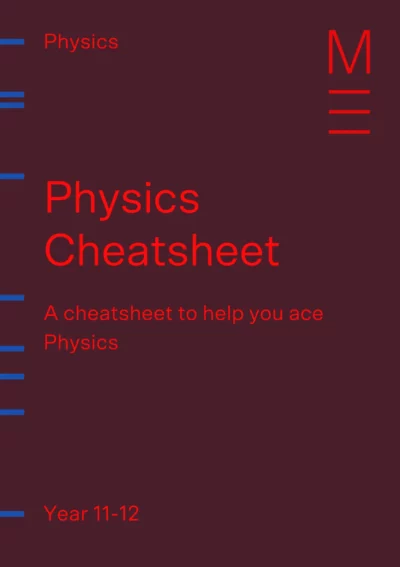Welcome to Matrix Education
To ensure we are showing you the most relevant content, please select your location below.
Select a year to see courses
Learn online or on-campus during the term or school holidays
Learn online or on-campus during the term or school holidays
Learn online or on-campus during the term or school holidays
Learn online or on-campus during the term or school holidays
Learn online or on-campus during the term or school holidays
Learn online or on-campus during the term or school holidays
Learn online or on-campus during the term or school holidays
Get HSC Trial exam ready in just a week
Get HSC exam ready in just a week
Select a year to see available courses
Science guides to help you get ahead
Science guides to help you get ahead
In this post, we share 10 Year 11 Physics: Electricity and Magnetism questions for you to test your skills on.

Join 75,893 students who already have a head start.
"*" indicates required fields
Related courses

Join 8000+ students each term who already have a head start on their school academic journey.
Are you fully charged and ready to go for your Yearly exams? Well, in this post, we’ve given you ten challenging electricity and magnetism practice questions to see how well you’ve attracted all of that Year 11 physics knowledge.
Charge up your Physics marks!
Get the competitive edge for your next Physics assessment! Fill out your details below to get this resource emailed to you. "*" indicates required fields
Download your FREE foldable Physics Cheatsheet

Download your FREE foldable Physics Cheatsheet
A metal rod with a negative charge is placed near a neutral metal conductor:
a) Define the term ‘polarisation’ with respect to electric charge.
b) Show the charge distribution in the neutral sphere.
c) Outline a procedure whereby the sphere gains a negative charge.
d) Outline a procedure whereby the sphere gains a positive charge.
Draw the electric or magnetic field lines in the following diagrams:
Calculate the force on a test charge of \(+0.5\text{ }\mu\text{C}\) in the following cases:
a) \(0.3\text{ m}\) away from a \(+2.2\text{ }\mu\text{C}\) charge.
b) Within an electric field of strength \( 15\text{ Vm}^{-1}\) upwards.
c) In the diagram below:
A scientist is examining the motion of individual electrons in a particle accelerator. The electrons in question have a velocity of \( 900,000\text{ ms}^{-1}\).
a) Calculate the work on each electron required to achieve this speed, if the electrons began at rest.
b) Determine the voltage required to accelerate the electrons to this speed.
c) \( 2.5 \times 10^{20}\) electrons pass by a single point every second. Calculate the magnitude of the current.
d) Calculate the minimum power required to achieve the current in (c).
A voltage is applied across two parallel plates as in the diagram below:
a) Draw the electric field between the plates and indicate the strength of the electric field.
b) A charge of \(-100\text{ }\mu\text{C}\) is suspended motionless between the plates. Calculate its mass.
c) Calculate the work done by the electric field on the \(-100\text{ }\mu\text{C}\) charge if it moves down by \(1\text{ cm}\).
An electric field has been set up between two parallel plates as shown below:
a) What is the distance between the parallel plates?
b) Draw on the diagram an equipotential line corresponding to \(4\text{ V}\) above the negative plate.
c) A negative charge is moved upwards along the \(4\text{ V}\) equipotential line from (b). Outline the amount of work done by the electric field as the charge moves from one side of the equipotential line to the other and justify your answer.
A student was investigating Ohm’s law by measuring the voltage drop across a resistor as a function of current. Their recorded results are below:
| Current (Amps) | Voltage (Volts) |
| 0.2 | 2.13 |
| 0.4 | 4.29 |
| 0.5 | 5.20 |
| 0.6 | 6.33 |
| 0.7 | 7.38 |
a) By plotting the results on the graph below, determine if the resistor is ohmic.
b) Determine the resistance of the resistor for a current of \(0.3 \text{ A}\).
A student constructs a circuit with an ammeter as shown below:
a) Determine the total resistance of the circuit.
b) If the reading on the ammeter is \(1.5\text{ A}\), calculate the voltage provided by the battery.
c) Determine the voltage drop across each of the resistors.
Consider the circuit below:
a) Determine the total current in the circuit.
b) Determine the voltage drop across each resistor.
c) Calculate the power dissipated by each resistor.
d) Explain what would happen if a wire was connected between points A and B on the circuit [Hint: calculate the potential at points A and B].
A solenoid is an electrical device that can be used to generate a magnetic field, consisting of coils of wire wrapped around a core:
The solenoid in the above diagram has \(10\) turns, and is \(20 \text{ cm}\) long.
a) Draw the magnetic field that will be generated by the solenoid. Label the north and south poles that are formed.
b) Calculate the strength of the magnetic field generated by a current of \(3.5 \text{ A}\) running through the solenoid. Assume that there is no material in the core.
c) Outline how the magnetic field would change if a ferromagnetic material was added to the core.
Get ahead of your peers with the Year 11 Matrix Physics course. With our HSC Physics experts, structured theory lessons, and comprehensive resources, we can help you boost your marks!
Physics doesn't need to be confusing
Expert teachers, detailed feedback, one-to-one help! Learn from home with Matrix+ Online Courses.
Question 1:
a) Polarisation refers to a separation of charge whereby one end of an object has a net positive charge and the other end has a net negative charge.
b)
c) Charging by contact: if the negatively charged rod touches the sphere some negative charge will be transferred onto the sphere, giving the sphere a net negative charge.
d) Charging by induction: The negatively charged rod is held close to the sphere but does not make contact. The sphere is instead connected to the ground with a conductor. Electrons move from the sphere to the ground, leaving the sphere with a net positive charge.
Question 2:
a)
b)
c)
d)
Question 3:
a) \(0.11 \text{ N}\) repulsive
b) \(7.5 \times 10^{-6} \text{ N}\) upwards
c) \(1.48 \times 10^{-4} \text{ N}\) to the right
Question 4:
a) \(3.69 \times 10^{-19} \text{ J}\)
b) \(2.3 \text{ V}\)
c) \(40 \text{ A}\)
d) \(92 \text{ W}\)
Question 5:
a)
b) \(3.06 \times 10^{-3}\text{ kg}\)
c) \(-3 \times 10^{-4}\text{ J}\)
Question 6:
a) \(0.02 \text{ m}\)
b)
c) Zero work is required to move along an equipotential. Equipotential surfaces are perpendicular to the field, and hence to the electric force a charge would experience. Thus the angle between the displacement and the force from the electric field is \(90^\circ\) and the work done by the electric field is \(W = F s \text{ cos }\theta = F s \text{ cos }90^\circ = 0\).
Question 7:
a)
The resistor is ohmic as voltage and current are proportional, indicated by the graph being a straight line.
b) \(10.5 \text{ }\Omega\), resistance should be obtained from the gradient of the line of best fit (and is constant, independent of current).
Question 8:
a) \(8.54 \text{ }\Omega\)
b) \(12.8 \text{ V}\)
c) \(2.3 \text{ V}\) for the \(4.2 \text{ }\Omega\) resistor.
\(2.3 \text{ V}\) for the \(2.5 \text{ }\Omega\) resistor.
\(10.5 \text{ V}\) for the \(7 \text{ }\Omega\) resistor.
Question 9:
a) \(9 \text{ A}\)
b) \(18 \text{ V}\) for the \(3 \text{ }\Omega\) resistor.
\(12 \text{ V}\) for the \(2 \text{ }\Omega\) resistor.
\(18 \text{ V}\) for the \(6 \text{ }\Omega\) resistor.
\(12 \text{ V}\) for the \(4 \text{ }\Omega\) resistor.
c) \(108 \text{ W}\) for the \(3 \text{ }\Omega\) resistor.
\(72 \text{ W}\) for the \(2 \text{ }\Omega\) resistor.
\(54 \text{ W}\) for the \(6 \text{ }\Omega\) resistor.
\(36 \text{ W}\) for the \(4 \text{ }\Omega\) resistor.
d) Nothing would happen. The potential at point A is \(12 \text{ V}\) and the potential at point B is \(12 \text{ V}\). Since there is no potential difference between points A and B, no current will flow if they are connected.
Question 10:
a)
b) \(B = 2.2 \times 10^{-4}\text{ T}\)
c) The magnetic field strength would greatly increase.
Written by Matrix Science Team
The Matrix Science Team are teachers and tutors with a passion for Science and a dedication to seeing Matrix Students achieving their academic goals.© Matrix Education and www.matrix.edu.au, 2025. Unauthorised use and/or duplication of this material without express and written permission from this site’s author and/or owner is strictly prohibited. Excerpts and links may be used, provided that full and clear credit is given to Matrix Education and www.matrix.edu.au with appropriate and specific direction to the original content.